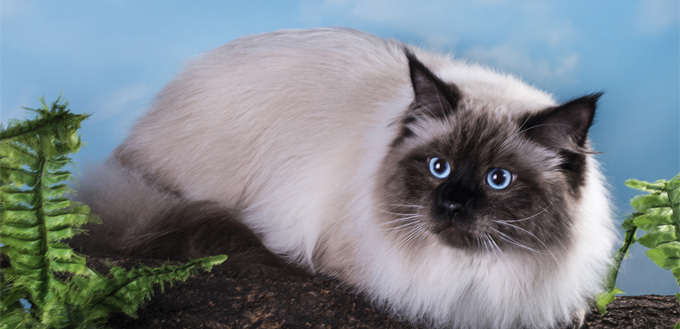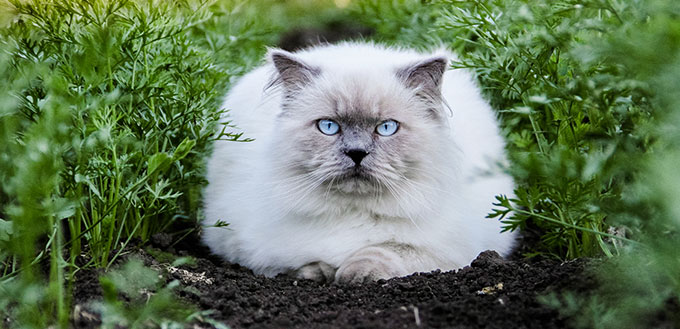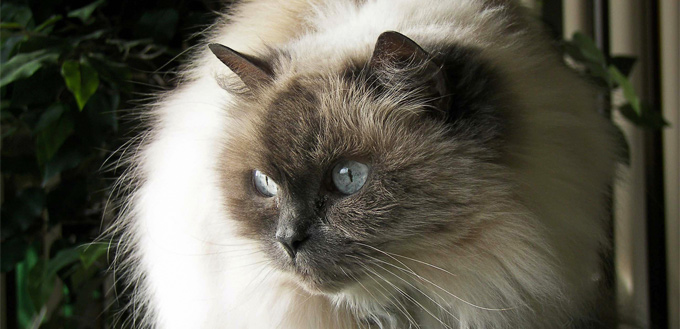Affectionate, gentle, and calm, but with bursts of kitten-like behavior, the Himalayan Cat is a massive kitty that comes with the very distinct colorpoints of a Siamese but with the fluffiness and temperament of a Persian. You’d be right for thinking that this is a cross between two purebred felines. As a matter of fact, some registries look at the Himalayan as a long-haired type of Siamese while others consider it as a colorpoint type of Persian. No matter how it is classified, the Himalayan is a strikingly beautiful kitty that has the sweet, sedate, and people-oriented nature of the Persian and the carefree yet helpful attitude of the Siamese.
History of the Himalayan Cat
It is no secret that cat breeders always adored the Persian, but would want the color point of a Siamese. This is the principal motivation of Dr. Clyde Keeler and Virginia Cobb in the creation of the Himalayan in 1931 with Newton’s Debutante being the first ever kitten to have resulted from the project. Dr. Keeler was a researcher for the Harvard Medical School while Cobb was a well-respected cat breeder. Initially, the project sought to determine how the Siamese colorpoint gene was transmitted or passed on. However, because of the elegance displayed by Newton’s Debutante, the program expanded to include other passable traits into the hybrid cat.

In 1935, British cat breeders who saw the Himalayan when they visited the US, brought several of these kitties back to the UK and started the breeding program in the British Isles. However, the Second World War severely disrupted the program. It was only a few years after the war that the Himalayan breeding program in the UK was reinitiated.
By the 1950s, Canadian cat breeder Ben Borrett sought to produce a Himalayan that had the distinct colorpoints of the Siamese but with substantially longer hair. Borrett used the Keeler-Cobb ‘recipe’ then bred the cat back with a Persian. He called it the Colorpoint Longhair and it is this cat that was officially recognized by the Governing Council of the Cat Fancy in 1955.
In 1957, the Cat Fanciers’ Association recognized the Himalayan as a distinct cat breed, not a special type of Persian or Siamese. This was after LaChiquita, a Himalayan cat bred by Margeurita Gorforth, became the American Cat Fanciers’ Association’s Champion. Cat registries in the US began accepting the Himalayan for show ring recognition by the 1960s and continued until the 1980s.
However, the organization’s Board of Directors reversed the classification in 1984 and considered the Himalayan as a sub-breed of the Persian. Even the American Cat Association thinks that the Himalayan is a type of Persian, made different only by its colorpoint.
Only the American Cat Fanciers’ Association, American Association of Cat Enthusiasts, Traditional Cat Association, and International Cat Association recognize the Himalayan as distinctly separate from the Persian cat.
Quick Facts About the Himalayan Cat Breed
- The International Cat Association and the American Cat Fanciers Association recognize the Himalayan as a distinct breed, not as a sub-breed of either the Persian or the Siamese.
- The American Cat Association and the Cat Fanciers Association look at the Himmie as a sub-breed of the Persian.
- The male Himalayan is considered as a large size of a cat, often weighing more than 12 pounds. The female Himmie is lighter and usually tips the scale at 8 to 12 pounds, classifying it as a medium-sized cat.
- Himmies can lead long lives that can reach 15 years, with a minimum at 9.
- The Himmie takes on the body of the classic Persian: large round head, short nose, small ears with rounded tips, full and stubby cheeks, and large, round, and adoring eyes.
- The Himmie also takes the neck characteristics of its Persian parent: thick yet short.
- The body is deceptively muscular and very sturdy. They call this ‘cobby’.
- The legs are strong and thick, but rather short. The paws are firm, round, and large; definitely a Persian.
- The coat patterns of a Himalayan are that of a Siamese. The shiny, thick, and long coat, however, is that of the Persian.
- The colorpoints can come in chocolate, red, flame, seal, lilac, fawn, cinnamon, blue-cream, lilac-cream, cream tortie, chocolate tortie, red lynx, blue lynx, seal lynx, lilac lynx, tortie lynx, chocolate lynx, blue-cream lynx, lilac-cream lynx, and chocolate-tortie lynx.
- The color of its body can come in different shades of white ranging all the way to fawn.
- The facial mask, ears, feet, and tail are usually colored.
- The eyes of the Himmie only come in one color – vivid, deep blue.
- Himmies can be of two different ‘looks’. Extreme Himalayans sport a flatter face and are usually entered in shows. Traditional Himalayans come with a not-so-flat face with the nose set slightly lower to allow for easier breathing.
Things You Should Know
We really have to emphasize that the Himalayan is a really gorgeous cat and its demeanor is so endearing that it wouldn’t surprise us a bit if you’re raring to get one. But before you do, it would be best to increase your knowledge of this kitty breed.
Health
The Himalayan’s strong Persian ancestry leaves it with one very troubling health concern – polycystic kidney disease. This results in the enlargement of the kidneys which can lead to their reduced ability to produce urine. If this is not managed, it can lead to kidney failure. The good thing is that having the Himalayan undergo DNA testing can help identify if they carry the genetic marker for PKD. If PKD genetic marker is identified the Himmie can be either spayed or neutered to help mitigate the risk.
Another health issue with the Himalayan is that it is very prone to breathing problems. This is especially true for show cats known as the Extreme Himmie with its characteristic flat face. While there is not much you can do to help correct the anatomy of a flattened face, there are some things that can be done to help it breathe a lot easier. For example, keeping it cool can help it from breathing heavily as these cats tend to overheat easily. More often than not, you’d have to keep them in air-conditioned rooms.
The tendency to become overweight is high in the Himalayan. Its energy level is low and while it may enjoy playing with you and your children, it won’t mind napping all day long. And if you happen to feed it more than you should, then you’re courting feline obesity.
Aside from these problems, other health issues that are prevalent in exotic cats can also be found in the Himmie. These can include feline hyperesthesia syndrome, seborrhea oleosa, dental malocclusion, excessive staining and tearing of the eyes, heat sensitivity, cherry eyes, progressive retinal atrophy, ringworm, and entropion, among others.

Feeding
The Himalayan deserves only the best when it comes to cat food. Unfortunately, different folks will have varying interpretations as to what constitutes the ‘best’. Ideally, you’d need a reduced calorie cat food that contains just the right amount of calories necessary to support its vital functions. It is a low-energy kitty so it doesn’t need hefty calories.
What it does need is plenty of animal-based proteins. The Himmie has a large, solid body that many think is full of fat. As a matter of fact, it has a very muscular body, neck, and limbs. The only way you can support the continuing development of its muscles is if you provide the right proteins and amino acids these tissues need.
Given that a Himmie requires a reduced-calorie, high-protein diet, canned or wet cat food is preferable to kibbles since it has significantly higher proportions of protein than carbs. It should bode well, too, for kitties that don’t drink that much as the moisture content of these kitty foods typically ranges between 78 and 82 percent.
Related Post: Best Dry Cat Food
Care
Caring for this kitty requires one very crucial task – grooming. It may have a very elegant-looking, long, and silky-smooth coat, but this doesn’t always stay tangle-free and clean. We’ll have a separate section for this.
The health of the Himalayan is another area that should receive the utmost importance in its care. Since it is prone to polycystic kidney disease, overheating, and breathing problems as well as other health concerns, regular veterinary checkups are a must. Genetic testing can be performed as soon as the Himmie arrives in your house so you’ll have a much better idea on how to better care for it.
This kitty, like all felines, is fastidious. And while it can ‘clean’ itself up, it cannot do so with its litter box. You’d have to pick up and discard the clumped litter every day and clean the litter box while also replacing the litter with fresh ones every week. After all, no cat would ever want to return to the same stinky box that it poops and urinates on.
Related Post: Best Cat Litter Box
Its eyes should be wiped every day to help prevent staining from its tears. Don’t worry, these are not tears of frustration. The problem is that they can ruin the elegant look of the Himalayan.
All Himalayans should be kept as indoor cats. They are very beautiful and are generally considered as exotic. You know what this means. They’re a prized catch for catnappers. There are a lot of dangers outside, too. There are stray cats, cat-aggressive dogs and other animals, and even pet-averse neighbors. Letting your cat out can expose it to these threats and risks. More importantly, however, Himmies are very intolerant of the heat. Keeping them indoors especially in air-conditioned rooms is one way to protect them.
Grooming
We mentioned above that the Himalayan will require frequent, regular grooming. To be more specific, it needs to be brushed or combed every day if you want its coat to retain its shine, softness, and overall elegance. Himmies’ coats can get easily tangled. Daily combing should help prevent this from occurring. However, it is very important that you be gentle so as not to break the hairs.
You should also bathe your Himmie once a month, at the very least. While this cat is an indoor kitty, its coat can get easily dirty. If you can bathe it once every 3 weeks, then so be it. However, don’t bathe it more frequently than needed as doing so will also remove the natural oils that are present on its skin.
The eyes should always be cleaned every day if you don’t want tear stains to become permanent and ruin the elegant look of this exotic cat. Daily dental care is also a must if you’re particularly concerned about the possibility of gum disease in cats. However, doing it once weekly shouldn’t hurt.

Temperament
The Himalayan cat carries many of the refined qualities of the Persian. It is quiet and generally placid. And while they can play with their favorite cat toys or their family, they do it more in a sedate kind of way. You’d most likely find a Himmie reclining gracefully, lounging on your sofa or even on its special bed rather than on your windowsill or top of the fridge. It’s not Garfield, obviously. However, its lifestyle is best defined by its preference for a more laidback afternoon. It doesn’t demand your attention either. Instead, it can do particularly well on its own. And if ever it feels it’s no longer getting the attention it deserves, you won’t see it complaining except for the speaking glance of its soulful, deep blue eyes and the soft, almost quiet meow.
One of the things people don’t know about the Himmie is that it is intelligent. If you can look past its docile nature, you can easily challenge its brain with tricks and puzzle toys. It’s not a dog, but you can easily train it certain tricks using positive reinforcement techniques.
The Himalayan Cat may not be a purebred feline, but it sure has the defining qualities of one. Despite its size, it’s a gentle kitty that is perfect for families who want a more laidback, more placid, yet truly beautiful cat.






